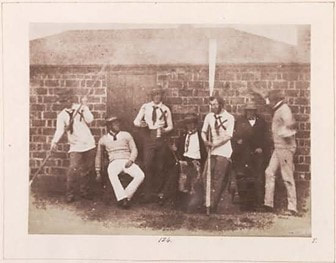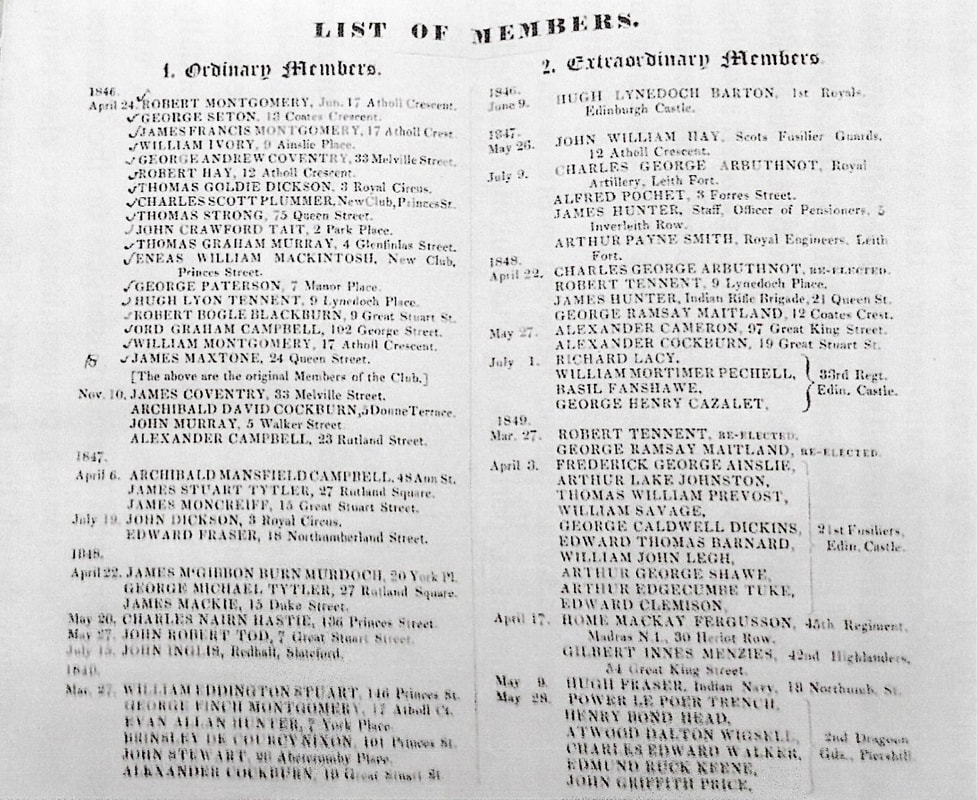The club was only two years old when seven of its members members appeared in these photos, which were preserved within the albums of the Edinburgh Calotype Club. Those books are now held by the National Library of Scotland, and the albums were fully digitised for the Pencils of Light exhibition.
Photography was in its infancy: the calotype process was invented by Henry Fox Talbot in 1841, and taken up in Edinburgh by Hill & Adamson a couple of years later. They took the first known sports photos of John Laing, a tennis or rackets player, who I have already written about.
It was a step forward from having a single subject who was standing motionless for a long exposure, to taking a photograph of a group, and the challenge was taken up by Hugh Lyon Tennent. He was a member of both the Calotype Club and the Rowing Club, and is credited with taking the photos, perhaps with the assistance of his brother Robert. The venue is almost certainly the club house at Fountainbridge, on the Union Canal.
Identifying the seven men was a challenge, as the caption for the first photo simply named the rowers as 'T Dickson, Hastie, Hugh Lyon Tennent, Rd Campbell, Seton, JS Tytler, Arbuthnot'. The second photo has the same subjects but Tennent has moved to the right of the group.
However, the recent publication of a history of St Andrew Boat Club has helped, not only to confirm all their identities, but also to pinpoint the date.
Dickson, Campbell, Tennent and Seton were all founding ordinary members in 1846, while Tytler joined the following year. The other two were only in Edinburgh for a short time and joined as extraordinary members: Hastie in 1848, and Arbuthnot for 1847-48. The date of the photo can therefore be pinpointed to the latter year.
The seven men in the photo can now be identified with some degree of certainty:
Thomas Goldie Dickson (1819-1905), an accountant who lived at 3 Royal Circus. Educated at Edinburgh Academy, he was also a member of John Hope's Foot-Ball Club in 1836. He was later notorious for his involvement in the Ardnamurchan clearances.
Charles Nairn Hastie (1809-1868), a solicitor from East Grinstead, Sussex, he was only in Edinburgh briefly and stayed at 136 Princes Street. In May 1848 he joined the Boat Club and was elected a Member of the Highland Agricultural Society.
Hugh Lyon Tennent (1817-1874), an advocate of 9 Lynedoch Place. Educated at Edinburgh Academy 1826-32. Related to the Tennents of brewing fame.
Ord Graham Campbell (1816-1890), a lawyer and Writer to the Signet, of 102 George Street. He was also a prominent golfer, member of the Royal & Ancient, and the Honorable Company of Edinburgh Golfers.
George Seton (1822-1908), an advocate of 13 Coates Crescent. Educated at Royal High School, then Edinburgh and Oxford Universities, he was a Fellow of the Royal Society of Edinburgh, an expert genealogist and served in the Royal Company of Archers.
James Stuart Fraser Tytler (1820-91), a lawyer and Writer to the Signet, of 27 Rutland Square. Educated at Edinburgh Academy and Edinburgh University, he became a Professor of Conveyancing at the university.
Charles George Arbuthnot (1824-1899), Born in Ireland and educated at Rugby, he was a Lieutenant in the Royal Artillery, based at Leith Fort. He went on to a prestigious army career, serving in Crimea, Afghanistan and India, becoming Lieutenant General Sir Charles Arbuthnot.
The history of the club is a fascinating read with many interesting photos, a 90 page paperback which is available from the club, price £10.
For further research, the club's extensive archives are held at the National Records of Scotland (Ref GD418).




 RSS Feed
RSS Feed